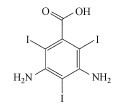2. 华东师范大学生态与环境科学学院, 上海 200241;
3. 崇明生态研究院, 上海 200062
2. School of Ecological and Environmental Sciences, East China Normal University, Shanghai 200241;
3. Institute of Eco-Chongming(IEC), Shanghai 200062
碘代X-射线造影剂是一类含碘的PPCPs(药物和个人护理品)污染物, 广泛应用于临床诊断中来增强人体器官和血管等软组织的影像观察效果.碘代造影剂多数是2, 4, 6-三碘苯甲酸的衍生物, 分为离子型和非离子型.其中, 离子型泛影酸钠结构中含有游离羧基和酰胺基, 其pKa1 = 1.13且pKa2 = 7.95, 在不同pH溶液中具有不同的存在形态.由于碘代造影剂分子中含有3个碘原子, 且是医院废水中可吸收有机碘的主要贡献者(Gartiser et al., 1996);又因其具有生物惰性和高稳定性的特点, 所以污水处理厂传统的处理工艺对碘代造影剂无法有效去除, 导致其最终进入到地表水、地下水和饮用水中(Ens et al., 2014).在饮用水的消毒过程中, 碘代造影剂的存在会生成比氯代、溴代副产物更具细胞毒性和遗传毒性的碘代消毒副产物(Yang et al., 2013; Ye et al., 2014).
目前, 对碘代造影剂的去除多采用生物降解法和高级氧化技术, 尤其是基于羟基(·OH)的高级氧化技术, 如臭氧氧化法(Ternes et al., 2003; Huber et al., 2005)、电离辐射法(Jeong et al., 2010; Velo-Gala et al., 2012)、光催化氧化法(Tian et al., 2014)、电化学氧化还原法(Eversloh et al., 2014; Del et al., 2015)和超声化学氧化法(Ning et al., 2009)等.近几年, 基于硫酸根自由基(SO4·-)的高级氧化技术被广泛应用于处理各种难生物降解有机物, 但目前仅有采用光活化过硫酸盐和电活化硫酸钠技术产生SO4·-处理离子型碘代造影剂泛影酸钠的研究(Velo-Gala et al., 2014; Radjenovic et al., 2014; Zhou et al., 2017).研究表明, 泛影酸钠在K2S2O8/UV体系的降解效率和反应速率常数要明显高于H2O2/UV体系(Velo-Gala et al., 2014; Zhou et al., 2017).相较于·OH, SO4·-具有较高的氧化还原电位(E0 = 2.5~3.1 V)和较长的半衰期, 而且降解有机物时受环境pH的影响较小.同时, SO4·-可以利用紫外光(Tian et al., 2018)、加热(Zrinyi et al., 2017; Liu et al., 2018)、碱(Peng et al., 2017; Zhou et al., 2018)、过渡金属离子催化(Liu et al., 2018; Zhang et al., 2018)、超声(Wei et al., 2017)及酚类和醌类有机物(Ahmad et al., 2013; Zhou et al., 2015)等方式活化过硫酸盐生成.热活化技术虽耗能较高, 但可操作性强, 加上过硫酸盐(PS)具有水溶性好且在污染系统中能长时间维持其稳态浓度(Yen et al., 2011)的优点, 有利于其应用于地下水和土壤污染的原位化学氧化修复.
因此, 本研究选用离子型碘代造影剂泛影酸钠为目标有机物, 以热活化过硫酸钾体系为研究基础, 考察底物浓度、温度、PS初始浓度、溶液初始pH及自然水体组分(包括氯离子、碱度、天然有机物)浓度对泛影酸钠降解效果的影响, 并根据产物对泛影酸钠降解机制进行研究, 以期为评价基于SO4·-的高级氧化技术应用于去除碘代造影剂的可行性提供参考.
2 材料与方法(Materials and methods) 2.1 试剂目标底物泛影酸钠(≥98%)购自Sigma-Aldrich公司, 过硫酸钾(K2S2O8, 99%)购自Alfa Aesar公司, 腐殖酸(HA)购自Aladdin公司, 甲醇(色谱纯)和甲酸(色谱纯)购自CNW Technologies GmbH公司, 氢氧化钠、硫酸、氯化钠、碳酸氢钠和亚硝酸钠均为分析纯以上级别.实验用水均为Milli-Q超纯水.
2.2 降解实验所有反应实验均是将装有50 mL反应液的锥形瓶(封口膜密封瓶口)置于恒温振荡水浴锅中进行, 水浴锅的温度可设定, 并通过持续振荡保证反应液始终处于完全混合的状态.反应前将装有未加入过硫酸钾溶液的反应液的锥形瓶置于水浴锅内预热10 min, 以保证反应液温度和水浴设定温度一致, 反应在加入过硫酸钾溶液后开始计时.分别取0、15、30、45、60、75、90 min时的反应液1 mL与等体积的甲醇溶液混合, 再置于冰水浴中以保证反应淬灭完全, 用高效液相色谱仪(HPLC)测定样品中泛影酸钠的剩余浓度.
在上述反应体系中, 分别考察了泛影酸钠的初始浓度(0.005、0.01、0.02、0.03 mmol·L-1)、温度(40、45、50、55、60 ℃)、过硫酸钾的初始浓度(0、2、4、6、8 mmol·L-1)、溶液初始pH (3.0、4.0、5.5、7.0、8.0、9.5)、HA浓度(0.5、5、10 mg·L-1)、Cl-浓度(0.5、1、5、10、100 mmol·L-1)、HCO3-浓度(1、4、10、20、50 mmol·L-1)对泛影酸钠降解的影响.
测矿化度时采用亚硝酸钠溶液作为淬灭剂进行淬灭.用于产物分析的样品放置于冰水浴内终止反应.实验过程采用两组平行实验进行样品测定, 用标准差方法分析实验数据的误差棒.
2.3 分析方法样品中的泛影酸钠剩余浓度使用岛津essentia LC-16型高效液相色谱仪进行定量分析.色谱柱采用岛津Wondasil C18-WR色谱柱(4.6 mm×250 mm, 5 μm), 流动相为甲酸溶液(pH = 3)和甲醇(体积比为84:16), 流动相流速为1.0 mL·min-1, 进样量为20 μL, 检测波长为238 nm.
矿化度通过采用耶拿multi N/C 3100 TOC仪测定反应液的总有机碳(TOC)计算得到.
采用LC-MS(Agilent LC1200/MS QTOF6520)对降解产物进行测定分析, 配置Agilent Poroshell 120 EC-C18色谱柱, 以0.1%甲酸水溶液和甲醇为流动相梯度洗脱.使用正离子模式进行全扫描(200~1000, m/z), 质谱参数如下:氮气作干燥气, 温度为300 ℃, 流速为6 L·min-1, 喷雾器压力为30 psi, 碎裂电压为135 V.
3 结果与讨论(Results and discussion) 3.1 温度的影响在泛影酸钠初始浓度为0.02 mmol·L-1, 过硫酸钾浓度为4 mmol·L-1, 溶液初始pH为5.5的特定条件下, 考察了反应温度在40~60 ℃范围内泛影酸钠的降解情况, 结果如图 1所示.当反应温度为40 ℃时, 在反应90 min内泛影酸钠的降解率仅为27.28%.温度升高到45、50、55、60 ℃后, 泛影酸钠的降解率分别提高至50.41%、73.69%、85.33%、94.48%.这表明反应温度和泛影酸钠的降解率呈正向关系, 提高体系温度可以加快泛影酸钠的降解.Yang等(2017)利用热活化过硫酸盐降解氟康唑时也发现, 随着温度从30 ℃上升到60 ℃, 8 h内氟康唑的去除率从41%提高到了80%.这是因为提高反应温度可以导致更多的过硫酸盐分解, 从而生成的SO4·-量也越多.过硫酸盐热分解产生硫酸根自由基的速率与反应体系温度密切相关.温度升高, 过硫酸盐的半衰期随之减小, 即过硫酸盐自身分解速率加快.当温度过高时会导致副反应作用逐渐增强, 加速体系中已产生的硫酸根自由基的淬灭.此外, 反应动力学规律也表明温度升高, 自由基与目标底物泛影酸钠之间的二级反应速率常数会增大.在不同反应温度下, 泛影酸钠的降解过程均基本符合准一级动力学模型(R2>0.90), 动力学方程如式(1)所示.

|
(1) |
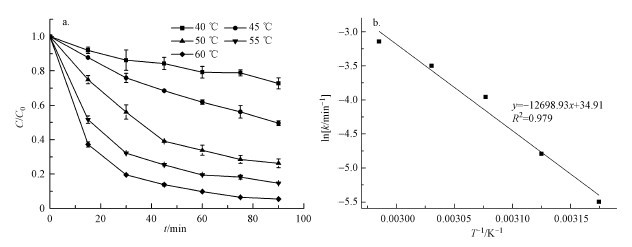 |
| 图 1 温度对泛影酸钠降解动力学的影响(a)及lnk与1/T的关系曲线(b) Fig. 1 Effect of temperature on the degradation of diatrizoate (a) and relationship line between lnk and 1/T (b) |
式中, C0为底物初始浓度(mmol·L-1), Ct为反应t时刻的底物剩余浓度(mmol·L-1), k为表观一级反应速率常数(min-1), t为反应时间(min).
反应温度从40 ℃逐步升高到60 ℃, 其相应的k值分别为4.10×10-3、8.30×10-3、1.91×10-2、3.02×10-2、4.32×10-2 min-1.将数值lnk和1/T进行拟合, 拟合曲线如图 1b所示, 结果表明, 两者具有良好的线性关系, 说明表观一级反应速率常数k与体系反应温度之间的关系遵循阿伦尼乌斯方程, 即如式(2)所示.

|
(2) |
式中, A为指前因子(min-1), Ea为反应表观活化能(J·mol-1), R为通用气体常数(8.314 J·mol-1·K-1), T为热力学温度(K).
根据线性斜率计算得到热活化过硫酸盐降解泛影酸钠反应的表观活化能Ea为105.57 kJ·mol-1, 其值接近于热活化过硫酸盐降解双酚S的表观活化能(112.9 kJ·mol-1)(Wang et al., 2017)及西药比索洛尔的表观活化能(119.8 kJ·mol-1)(Ghauch et al., 2012).
3.2 过硫酸钾初始浓度的影响在泛影酸钠初始浓度为0.02 mmol·L-1, 溶液初始pH为5.5, 反应体系温度为55 ℃的条件下, 向反应体系分别加入浓度为0、2、4、6、8 mmol·L-1的过硫酸钾溶液, 研究过硫酸钾浓度对降解的影响, 结果如图 2所示.在未投加氧化剂的情况下, 泛影酸钠在加热过程中几乎没有发生降解, 说明泛影酸钠性质稳定, 受热不分解.随着过硫酸钾浓度的增大, 泛影酸钠的降解率也相应提高.在不同浓度过硫酸钾投加下, 泛影酸钠的降解也符合一级动力学模型.当过硫酸钾浓度从2 mmol·L-1增大到8 mmol·L-1时, 反应90 min内泛影酸钠的降解率从72.45%提高到94.27%, 相应的k值从1.91×10-2 min-1增大到4.55×10-2 min-1.类似的现象同样出现在热活化过硫酸钾降解其他有机物中(Ghauch et al., 2012; Wang et al., 2017; Liu et al., 2018).从图 2b中可以看出, 随着过硫酸钾浓度在2~8 mmol·L-1范围内增加, 一级动力学反应速率常数k呈线性增加, 且两者之间的线性回归方程为k = 0.0062×[K2S2O8]0, 相应的可决系数R2为0.98.
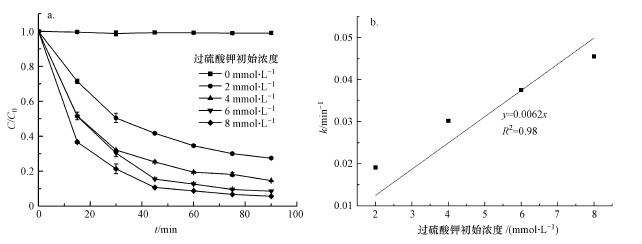 |
| 图 2 过硫酸钾初始浓度对泛影酸钠降解(a)及其表观速率常数(b)的影响 Fig. 2 Effect of initial PS concentration on the degradation of diatrizoate (a) and apparent rate constant(b) |
在过硫酸钾浓度为4 mmol·L-1, 反应体系温度为55 ℃, 溶液初始pH为5.5的条件下, 配制了初始浓度分别为0.005、0.01、0.02、0.03 mmol·L-1的泛影酸钠溶液, 考察不同泛影酸钠初始浓度对降解的影响.如图 3所示, 当泛影酸钠初始浓度为0.005、0.01、0.02、0.03 mmol·L-1时, 反应15 min内泛影酸钠降解率分别为68.05%、54.90%、48.48%、31.09%.结果表明, 在一定条件下, 泛影酸钠的初始浓度与泛影酸钠降解率呈负向关系.这是因为当过硫酸钾初始浓度和活化温度一定的情况下, 体系所生成的SO4·-理论上是等量的.在不同泛影酸钠初始浓度下降解仍符合一级动力学模型, k值分别为5.70×10-2、4.96×10-2、2.76×10-2、1.96×10-2 min-1.底物浓度与表观反应速率常数k之间的有较好的线性关系, 其方程为k = -1.54×[泛影酸钠]0+0.064, 可决系数R2为0.98.
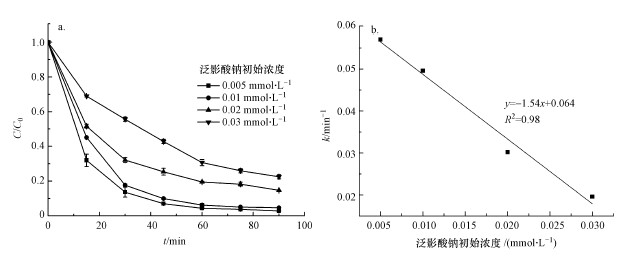 |
| 图 3 泛影酸钠初始浓度对泛影酸钠降解(a)及其表观速率常数(b)的影响 Fig. 3 Effect of initial substrate concentration on the degradation of diatrizoate (a) and apparent rate constant (b) |
在泛影酸钠初始浓度为0.02 mmol·L-1, 过硫酸钾浓度为4 mmol·L-1, 反应体系温度为55 ℃时, 研究了溶液初始pH对泛影酸钠降解的影响.从整体上看, 溶液初始pH对降解的影响并不显著, 降解效果只在初始pH值为3.0和9.5时发生了细微的减弱.如图 4b所示, 在不调节溶液初始pH情况下, 表观反应速率常数k为3.02×10-2 min-1, 而当pH调整为3.0时k值减小为2.56×10-2 min-1, 当pH调整为9.5时k值更是降低到2.03×10-2 min-1.这种现象与Zhou等(2017)研究溶液初始pH对光活化过硫酸盐降解泛影酸钠影响的结果相类似.这可能是因为在酸性条件下, 过硫酸盐可以通过酸催化促进SO4·-的生成(Deng et al., 2013), 所以导致SO4·-的产量比在碱性条件下更高;或者是在碱性条件下SO4·-被转化成·OH, 而·OH对泛影酸钠的攻击作用不如SO4·-, 这就解释了为什么在酸性条件下泛影酸钠的降解效果比在pH值为9.5时的降解效果好.此外, 式(3)说明了可能存在没有发生酸催化生成SO4·-, 而是H+与S2O82-结合生成了不具有活性的非自由基离子的情况, 从而减小了体系中可以被热激发生成SO4·-的过硫酸盐浓度(Kolthoff et al., 1951).因此, 溶液初始pH值为3.0时的降解效果稍逊色于在未调节pH(pH = 5.5)条件下的降解效果.

|
(3) |
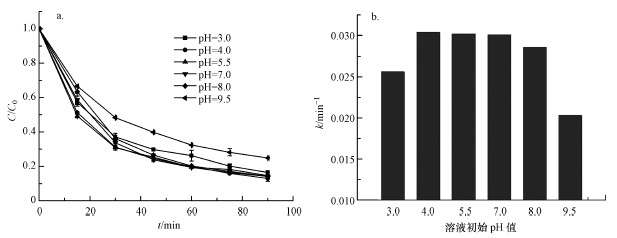 |
| 图 4 溶液初始pH对泛影酸钠降解(a)及其表观速率常数(b)的影响 Fig. 4 Effect of initial solution pH on the degradation of diatrizoate (a) and rate constant (b) |
自然水环境中广泛存在氯化物、天然有机物质和碱度等组分, 而这些组分又可能对基于SO4·-的高级氧化过程有一定影响(Lutze et al., 2015; Liu et al., 2018; Huang et al., 2018).因此, 本研究考察了Cl-、HCO3-和腐殖酸的投加对热活化过硫酸盐降解泛影酸钠的影响.
众所周知, 溶液中Cl-能被SO4·-氧化生成氯自由基和游离氯(式(4)~(8))(Wang et al., 2017a; 2017b; Fang et al., 2017; Huang et al., 2018; Yang et al., 2018).由于氯自由基和游离氯均具有选择性, Cl-的存在往往会抑制SO4·-对有机物的降解.如图 5a所示, Cl-浓度在0.5~100 mmol·L-1范围内, 泛影酸钠降解受到了不同程度的抑制.在体系中Cl-浓度小于1 mmol·L-1时, 泛影酸钠的降解受到了明显的抑制, 反应速率常数k甚至减小到9.81×10-3 min-1.但随着Cl-浓度的增大, 抑制作用开始逐步减弱, 当Cl-浓度增大到100 mmol·L-1时反应速率常数k为2.80×10-2 min-1, 与不加氯时的k值(3.02×10-2 min-1)较为接近.这是因为不同的Cl-投加量, 相对应的体系中氯自由基或游离氯所占的比例会不同, 并且它们与泛影酸钠之间的二级反应速率常数也存在差异, 从而出现了这种较为复杂的抑制作用.此外, 有研究表明, 反应介质的高离子强度对活化过硫酸盐降解有机物有促进作用(Lou et al., 2013), 因此, 较高Cl-浓度的抑制作用减弱可能也与离子强度有关.

|
(4) |

|
(5) |

|
(6) |

|
(7) |

|
(8) |
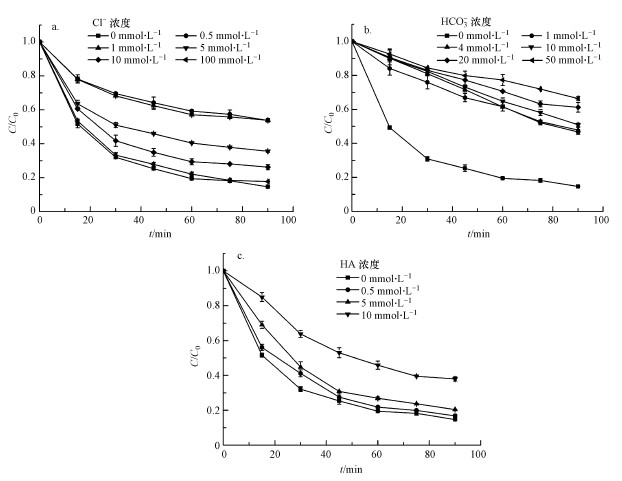 |
| 图 5 水体中Cl-(a)、HCO3- (b)和HA (c)对泛影酸钠降解的影响 Fig. 5 Effect of Cl-(a), HCO3- (b) and HA (c) on the degradation of diatrizoate |
如图 5b所示, 与Cl-的影响不同, HCO3-对泛影酸钠降解的抑制作用随HCO3-浓度的增大而逐渐增强.HCO3-浓度从1 mmol·L-1增大到50 mmol·L-1时, 反应90 min内泛影酸钠的降解率从53.27%降低到33.56%, 相应的反应速率常数k从8.61×10-3 min-1减小到4.73×10-3 min-1.HCO3-对泛影酸钠降解显著的抑制作用可能是由于溶液中部分HCO3-快速转化为CO32-、HCO3-和CO32-并进一步与SO4·-反应生成HCO3·和CO3·-(式(9)~(11)), 而它们的氧化活性很弱所导致的.另一方面, HCO3-的加入增大了溶液的碱性, 而泛影酸钠在碱性环境下的降解效果不如酸性条件, 因此, 从碱度方面考虑, 投加HCO3-会在一定程度上减弱泛影酸钠的降解.

|
(9) |

|
(10) |

|
(11) |
腐殖酸(HA)是水体和土壤中天然有机质的主要成分, 因此, 本研究选用HA模拟自然水体中的天然有机质.在泛影酸钠初始浓度为0.02 mmol·L-1, 过硫酸钾浓度为4 mmol·L-1, 反应体系温度为55 ℃, 不调节溶液pH的条件下, 考察了不同浓度HA对泛影酸钠降解的影响.如图 5c所示, HA对泛影酸钠的降解有一定抑制作用, HA的浓度越大, 抑制作用越明显.当HA浓度为0、0.5、5、10 mg·L-1时, 反应15 min内泛影酸钠的降解率分别为48.36%、43.95%、30.94%、15.05%, 反应60 min内反应速率常数k分别为3.20×10-2、2.72×10-2、2.40×10-2、1.35×10-2 min-1.这是因为HA分子的基本结构是芳环和酯环, 环上连有羟基、羧基、羰基等官能团, 它们都是富含电子的基团, 会与泛影酸钠竞争消耗亲电自由基SO4·-而导致降解被抑制.
3.6 矿化度及降解产物在泛影酸钠初始浓度为0.02 mmol·L-1, 过硫酸钾浓度为4 mmol·L-1, 反应温度为55 ℃, 溶液初始pH值为5.5的条件下, 探究了体系中泛影酸钠的矿化情况(即TOC去除率), 结果见图 6.由图可知, 随着时间的推移, 反应液中的TOC含量逐渐减少, 在反应180 min内, 泛影酸钠的矿化率为19.12%.虽然泛影酸钠在降解过程中有一定程度的矿化, 但矿化程度并不理想, 这可能是因为泛影酸钠的降解只发生侧链的断裂, 如碘的脱落, 并未实现苯环的开环.
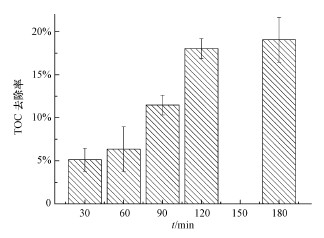 |
| 图 6 泛影酸钠降解过程中的矿化程度 Fig. 6 The mineralization during the degradation of diatrizoate |
利用LC-ESI(+)-QTOF/MS共检测到3种泛影酸钠降解产物, 相应的分子式、化学结构式、质荷比及保留时间如表 1所示.
| 表 1 泛影酸钠降解产物 Table 1 Transformation products of diatrizoate |
产物1和产物2的形成是由于苯环侧链发生酰胺水解, 在Azerrad等(2016)利用UVA-TiO2降解泛影酸钠和Velo-Gala等(2012)采用γ辐射降解泛影酸钠的研究中也有报道.产物3在产物1的基础上, 苯环侧链的氨基发生氧化;同时, SO4·-攻击泛影酸钠的苯环形成正碳阳离子自由基, 在溶液中氢氧根的加入下使苯环上的羧基脱去, 该反应类似于·OH攻击泛影酸钠的甲酸酯部分产生酚类产物(Jeong et al., 2010).产物的鉴别进一步验证了之前的推测, 泛影酸钠的降解途径主要是苯环侧链上酰胺键(C—N键)的断裂(Zhou et al., 2017; Hu et al., 2017)、氨基氧化(Zhou et al., 2017)及苯环上的脱羧基羟基化(Hu et al., 2017).
4 结论(Conclusions)1) 热活化过硫酸钾降解泛影酸钠遵循一级反应动力学规律.升高温度、增加过硫酸钾浓度或者降低底物浓度可以提高泛影酸钠降解的速率常数.
2) 泛影酸钠在热活化过硫酸盐体系内降解受周边环境pH的影响较小, 在酸性和中性条件下, 降解效果优于碱性环境.
3) 自然水环境中的常见组分, 如Cl-、HCO3-和HA, 对热活化过硫酸盐氧化体系内泛影酸钠降解有不同程度的抑制作用.
4) 在热活化过硫酸盐氧化体系内, 泛影酸钠虽然有良好的降解率, 但矿化效果并不理想.同时结合降解产物的分析, 表明泛影酸钠的降解是因为苯环侧链结构的改变.泛影酸钠降解途径主要包括酰胺键断裂、氨基氧化和脱羧基羟基化.
Ahmad M, Teel A L, Watts R J. 2013. Mechanism of persulfate activation by phenols[J]. Environmental Science & Technology, 47(11): 5864–5871.
|
Azerrad S P, Eversloh C L, Gilboa M, et al. 2016. Identification of transformation products during advanced oxidation of diatrizoate:Effect of water matrix and oxidation process[J]. Water Research, 103: 424–434.
DOI:10.1016/j.watres.2016.07.066
|
Del Moro G, Pastore C, Di Iaconi C, et al. 2015. Iodinated contrast media electrodegradation:Process performance and degradation pathways[J]. Science of the Total Environment, 506-507: 631–643.
DOI:10.1016/j.scitotenv.2014.10.115
|
Deng J, Shao Y, Gao N, et al. 2013. Thermally activated persulfate(TAP) oxidation of antiepileptic drug carbamazepine in water[J]. Chemical Engineering Journal, 228: 765–771.
DOI:10.1016/j.cej.2013.05.044
|
Ens W, Senner F, Gygax B, et al. 2014. Development, valisation, and application of a novel LC-MS/MS trace analysis method for the simultaneous quantification of seven iodinated X-ray contrast media and three artificial sweeteners in surface, ground, and drinking water[J]. Analytical and Bioanalytical Chemistry, 406(12): 2789–2798.
DOI:10.1007/s00216-014-7712-0
|
Eversloh C L, Henning N, Schulz M, et al. 2014. Electrochemical treatment of iopromide under conditions of reverse osmosis concentrates-Elucidation of the degradation pathway[J]. Water Research, 48: 237–246.
DOI:10.1016/j.watres.2013.09.035
|
Fang C L, Lou X Y, Huang Y, et al. 2017. Monochlorophenols degradation by UV/persulfate is immune to the presence of chloride:Illusion or reality?[J]. Chemical Engineering Journal, 323: 124–133.
DOI:10.1016/j.cej.2017.04.094
|
Gartiser S, Brinker L, Erbe T, et al. 1996. Contamination of hospital wastewater with hazardous compounds as defined by 7a WHG[J]. Acta Hydrochimica Et Hydrobiologic, 24(2): 90–97.
DOI:10.1002/(ISSN)1521-401X
|
Ghauch A, Tuqan A M. 2012. Oxidation of bisoprolol in heated persulfate/H2O systems:kinetics and products[J]. Chemical Engineering Journal, 183: 162–171.
DOI:10.1016/j.cej.2011.12.048
|
Hu J, Dong H Y, Qu J H, et al. 2017. Enhanced degradation of iopamidol by peroxymonosulfate catalyzed by two pipe corrosion products (CuO and d-MnO2)[J]. Water Research, 112: 1–8.
DOI:10.1016/j.watres.2017.01.025
|
Huang Y, Sheng B, Wang Z H, et al. 2018. Deciphering the degradation/chlorination mechanisms of maleic acid in the Fe(Ⅱ)/peroxymonosulfate process:An often overlooked effect of chloride[J]. Water Research, 145: 453–463.
DOI:10.1016/j.watres.2018.08.055
|
Huber M M, Gobel A, Joss A, et al. 2005. Oxidation of pharmaceuticals during ozonation of municipal wastewater effluents:A pilot study[J]. Environmental Science & Technology, 39(11): 4290–4299.
|
Jeong J, Jung J, Cooper W J, et al. 2010. Degradation mechanisms and kinetic studies for the treatment of X-ray contrast media compounds by advanced oxidation/reduction processes[J]. Water Research, 44: 4391–4398.
DOI:10.1016/j.watres.2010.05.054
|
Kolthoff I M, Miller I K. 1951. The chemistry of persulfate.I.The kinetics and mechanism of the decomposition of the persulfate ion in aqueous medium[J]. Journal of the American Chemical Society, 73: 1–30.
DOI:10.1021/ja01145a001
|
Liu L, Lin S, Zhang W, et al. 2018. Kinetic and mechanistic investigations of the degradation of sulfachloropyridazine in heat-activated persulfate oxidation process[J]. Chemical Engineering Journal, 346: 515–524.
DOI:10.1016/j.cej.2018.04.068
|
Liu Y D, Zhou A G, Gan Y Q, et al. 2018. Roles of hydroxyl and sulfate radicals in degradation of trichloroethene by persulfate activated with Fe2+ and zero-valent iron:Insights from carbon isotope fractionation[J]. Journal of Hazardous Materials, 344: 98–103.
DOI:10.1016/j.jhazmat.2017.09.048
|
Lou X Y, Guo Y G, Xiao D X, et al. 2013. Rapid dye degradation with reactive oxidants generated by chloride-induced peroxymonosulfate activation[J]. Environmental Science & Pollution Research, 20: 6317–6323.
|
Lutze H V, Bircher S, Rapp I, et al. 2015. Degradation of chlorotriazine pesticides by sulfate radicals and the influence of organic matter[J]. Environmental Science & Technology, 49: 1673.
|
Ning B, Graham N J D, Lickiss P D. 2009. A comparison of ultrasound-based advanced oxidation processes for the removal of X-ray contrast media[J]. Water Science Technology, 60: 2383–2390.
DOI:10.2166/wst.2009.661
|
Peng H J, Xu L Y, Zhang W, et al. 2017. Different kinds of persulfate activation with base for the oxidation and mechanism of BDE209 in a spiked soil system[J]. Science of the Total Environment, 574: 307–313.
DOI:10.1016/j.scitotenv.2016.09.057
|
Radjenovic J, Petrovic M. 2016. Sulfate-mediated electrooxidation of X-ray contrast media on borondoped diamond anode[J]. Water Research, 94: 128–135.
DOI:10.1016/j.watres.2016.02.045
|
Ternes T, Stüber J, Herrmann N, et al. 2003. Ozonation:A tool for removal of pharmaceuticals, contrast media and musk fragrances from wastewater[J]. Water Research, 37: 1976–1982.
DOI:10.1016/S0043-1354(02)00570-5
|
Tian F X, Xu B, Lin Y L, et al. 2014. Photodegradation kinetics of iopamidol by UV irradiation and enhanced formation of iodinated disinfection by-products in sequential oxidation processes[J]. Water Research, 58: 198–208.
DOI:10.1016/j.watres.2014.03.069
|
Tian J Y, Wu C W, Yu H R, et al. 2018. Applying ultraviolet/persulfate (UV/PS) pre-oxidation for controlling ultrafiltration membrane fouling by natural organic matter (NOM) in surface water[J]. Water Research, 132: 190–199.
DOI:10.1016/j.watres.2018.01.005
|
Velo-Gala I, López-Peñalver J J, Sánchez-Polo M, et al. 2012. Ionic X-ray contrast media degradation in aqueous solution induced by gamma radiation[J]. Chemical Engineering Journal, 195-196: 369–376.
DOI:10.1016/j.cej.2012.04.046
|
Velo-Gala I, López-Peñalver J J, Sánchez-Polo M, et al. 2014. Comparative study of oxidative degradation of sodium diatrizoate in aqueous solution by H2O2/Fe2+, H2O2/Fe3+, Fe(Ⅵ) and UV, H2O2/UV, K2S2O8/UV[J]. Chemical Engineering Journal, 241: 504–512.
DOI:10.1016/j.cej.2013.10.036
|
Wang Q, Lu X H, Cao Y, et al. 2017. Degradation of Bisphenol S by heat activated persulfate:Kinetics study, transformation pathways and influences of co-existing chemicals[J]. Chemical Engineering Journal, 328: 236–245.
DOI:10.1016/j.cej.2017.07.041
|
Wang Z H, Feng M, Fang C L, et al. 2017a. Both degradation and AOX accumulation are significantly enhanced inUV/peroxymonosulfate/4-chlorophenol/Cl- system:two sides of the same coin?[J]. RSC Advance, 7: 12318–12321.
DOI:10.1039/C7RA01294B
|
Wang Z H, Ai L Y, Huang Y, et al. 2017b. Degradation of azo dye with activated peroxygens:when zero-valent iron meets chloride[J]. RSC Advance, 7: 30941–30948.
DOI:10.1039/C7RA03872K
|
Wei Z S, Villamena F A, Weavers L K. 2017. Kinetics and mechanism of ultrasonic activation of persulfate:An in situ EPR spin trapping study[J]. Environmental Science & Technology, 51(6): 3410–3417.
|
Yang F, Huang Y, Fang C L, et al. 2018. Peroxymonosulfate/base process in saline wastewater treatment:The fight between alkalinity and chloride ions[J]. Chemosphere, 199: 84–88.
DOI:10.1016/j.chemosphere.2018.02.023
|
Yang J F, Yang L M, Zhang S B, et al. 2017. Degradation of azole fungicide fluconazole in aqueous solution by thermally activated persulfate[J]. Chemical Engineering Journal, 321: 113–122.
DOI:10.1016/j.cej.2017.03.103
|
Yang M, Zhang X. 2013. Comparative developmental toxicity of new aromatic halogenated DBPs in a chlorinated saline sewage effluent to the marine polychaete platynereis dumerilii[J]. Environmental Science & Technology, 47: 10868–10876.
|
Ye T, Xu B, Wang Z, Zhang T, et al. 2014. Comparison of iodinated trihalomethanes formation during aqueous chlor(am)ination of different iodinated X-ray contrast media compounds in the presence of natural organic matter[J]. Water Research, 66: 390–398.
DOI:10.1016/j.watres.2014.08.044
|
Yen C H, Chen K F, Kao C M, et al. 2011. Application of persulfate to remediate petroleum hydrocarbon contaminated soil:feasibility and comparison with common oxidants[J]. Journal of Hazardous Materials, 186: 2097–2102.
DOI:10.1016/j.jhazmat.2010.12.129
|
Zhang Y C, Zhang Q, Dong Z Y, et al. 2018. Degradation of acetaminophen with ferrous/copperoxide activate persulfate:Synergism of iron and copper[J]. Water Research, 146: 232–243.
DOI:10.1016/j.watres.2018.09.028
|
Zhou L, Ferronato C, Chovelon J M, et al. 2017. Investigations of diatrizoate degradation by photo-activated persulfate[J]. Chemical Engineering Journal, 311: 28–36.
DOI:10.1016/j.cej.2016.11.066
|
Zhou Y, Jiang J, Gao Y, et al. 2015. Activation of Peroxymonosulfate by Benzoquinone:A Novel Nonradical Oxidation Process[J]. Environmental Science & Technology, 49(21): 12941–12950.
|
Zhou Y Y, Xiang Y J, He Y Z, et al. 2018. Applications and factors influencing of the persulfate-based advanced oxidation processes for the remediation of groundwater and soil contaminated with organic compounds[J]. Journal of Hazardous Materials, 359: 396–407.
DOI:10.1016/j.jhazmat.2018.07.083
|
Zrinyi N, Pham A L. 2017. Oxidation of benzoic acid by heat-activated persulfate:Effect of temperature on transformation pathway and product distribution[J]. Water Research, 120: 43–51.
DOI:10.1016/j.watres.2017.04.066
|
 2019, Vol. 39
2019, Vol. 39





